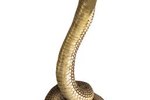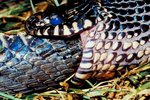
If you suffer from ophidiophobia -- the fear of snakes -- you might consider canceling your trip along the Nile River. At least 10 species of venomous snakes and more species of nonvenomous ones slither, swim, climb and crawl along the world's longest river as it winds along its 4,132-mile journey from northeast Africa to the Mediterranean Sea. The temperate climate ranges from 60 to 117 degrees Fahrenheit, providing an ideal environment for snakes to flourish.
Your Worst Nightmare
Some of the world's most venomous snakes make their home along the Nile River. The Egyptian banded cobra's venom can kill a man within minutes, although the snake is also capable of biting without injecting venom. The red spitting cobra spits venom into the eyes of an intruder, causing severe pain and sometimes permanent blindness. Black mambas can travel up to 12 miles per hour but prefer to flee rather than confront a human. When cornered they strike repeatedly, injecting potent venom that kills within minutes. Other species to look out for include the puff adder -- which is known for sunbathing lazily on footpaths -- and several species of vipers.
High Above the Ground
The African egg-eating snake spends most his life in trees, subsisting almost entirely on bird eggs. The snake consumes eggs as large as chicken eggs thanks to a hinged jaw and small teeth. When the snake swallows the egg whole, spines along the esophagus break open the shell, releasing its contents. After the egg is devoid of its contents, the snake simply regurgitates the eggshell. The boomslang and green mamba live in trees along the southernmost part of the river. The boomslang's anticoagulant venom causes his victim to bleed to death, and the green mamba's venom affects the victim's nerves and brain. Fortunately, both snakes prefer to escape from humans, rather than defend against them, when given a chance.
Snakes in the Water
Some snakes, such as the dice snake, live almost exclusively in the water, feeding on fish, frogs and invertebrates. The dice snake is nonvenomous but secretes a nasty smell from his cloaca when disturbed. You may see large groups of them mating in the river from March through May. The African beauty snake is another common water inhabitant, slithering through grassy or reedy areas along the banks as he hunts for frogs, lizards, mice and smaller snakes. His mildly toxic venom causes local inflammation, but it is not usually fatal.
The Big Squeeze
Look carefully along sandy banks and you may spy an Egyptian sand boa, lying in wait for prey with only his head visible. When a mouse or other small mammal passes within striking distance, the snake explodes out of the sand, grasping it with his mouth and constricting around it to kill it before consuming it. The sand boa rarely grows to more than 3 feet long and exhibits a docile attitude, making the species popular in the pet industry. On the opposite end of the scale, the African rock python is the largest snake along the Nile -- sometimes more than 20 feet long -- with an aggressive attitude. These giant snakes along the river can swallow an entire antelope or crocodile. The snakes also prey on humans when given the opportunity.
References
- Encyclopaedia Britannica: Nile River
- Encyclopedia of Life: Diced Water Snake
- Encyclopaedia Britannica: Egg-Eating Snake
- iNaturalist.org: Kenyan Sand Boa
- Encyclopedia of Life: African Rock Python
- Smithsonian National Zoological Park: Reptiles and Amphibians Fact Sheets - Egyptian Banded Cobra
- American Museum of Natural History: Red Spitting Cobra
- Encyclopedia of Life: African Beauty Snake
Resources
Photo Credits
-
Jupiterimages/Photos.com/Getty Images
Writer Bio
Indulging her passion for vacation vagary through the written word on a full-time basis since 2010, travel funster Jodi Thornton-O'Connell guides readers to the unexpected, quirky, and awe-inspiring.




